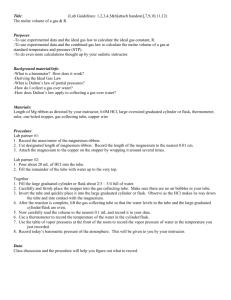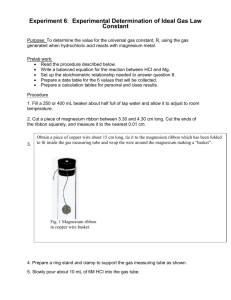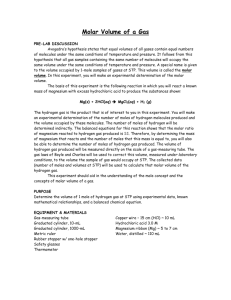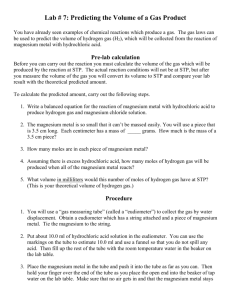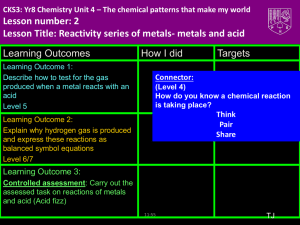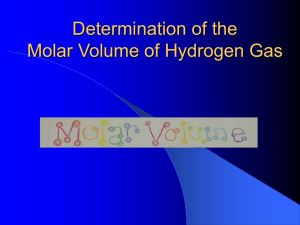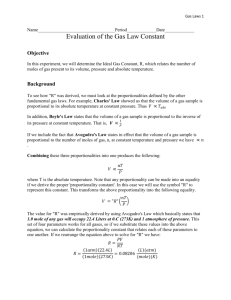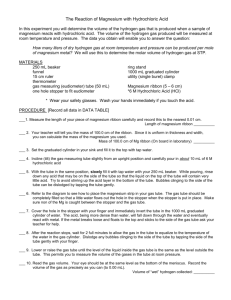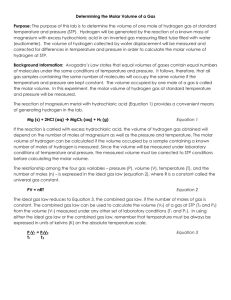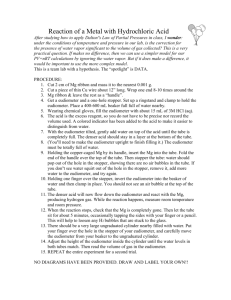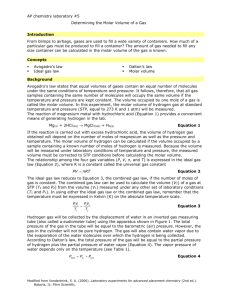The Reaction of Magnesium with Hydrochloric Acid Lab
advertisement
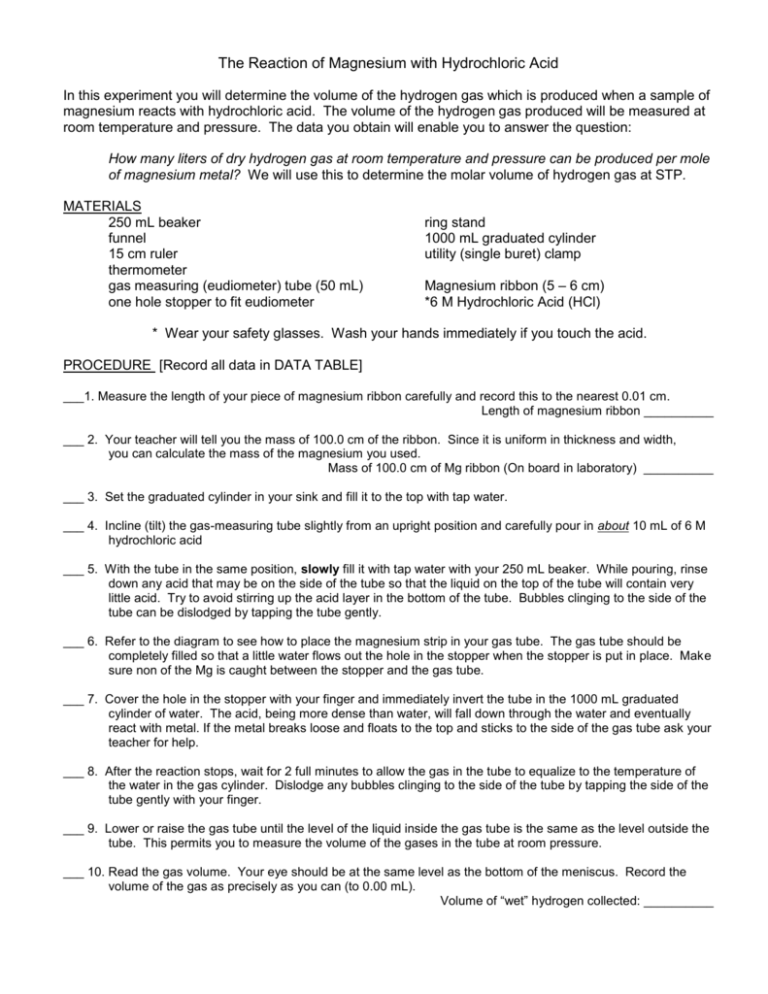
The Reaction of Magnesium with Hydrochloric Acid In this experiment you will determine the volume of the hydrogen gas which is produced when a sample of magnesium reacts with hydrochloric acid. The volume of the hydrogen gas produced will be measured at room temperature and pressure. The data you obtain will enable you to answer the question: How many liters of dry hydrogen gas at room temperature and pressure can be produced per mole of magnesium metal? We will use this to determine the molar volume of hydrogen gas at STP. MATERIALS 250 mL beaker funnel 15 cm ruler thermometer gas measuring (eudiometer) tube (50 mL) one hole stopper to fit eudiometer ring stand 1000 mL graduated cylinder utility (single buret) clamp Magnesium ribbon (5 – 6 cm) *6 M Hydrochloric Acid (HCl) * Wear your safety glasses. Wash your hands immediately if you touch the acid. PROCEDURE [Record all data in DATA TABLE] ___1. Measure the length of your piece of magnesium ribbon carefully and record this to the nearest 0.01 cm. Length of magnesium ribbon __________ ___ 2. Your teacher will tell you the mass of 100.0 cm of the ribbon. Since it is uniform in thickness and width, you can calculate the mass of the magnesium you used. Mass of 100.0 cm of Mg ribbon (On board in laboratory) __________ ___ 3. Set the graduated cylinder in your sink and fill it to the top with tap water. ___ 4. Incline (tilt) the gas-measuring tube slightly from an upright position and carefully pour in about 10 mL of 6 M hydrochloric acid ___ 5. With the tube in the same position, slowly fill it with tap water with your 250 mL beaker. While pouring, rinse down any acid that may be on the side of the tube so that the liquid on the top of the tube will contain very little acid. Try to avoid stirring up the acid layer in the bottom of the tube. Bubbles clinging to the side of the tube can be dislodged by tapping the tube gently. ___ 6. Refer to the diagram to see how to place the magnesium strip in your gas tube. The gas tube should be completely filled so that a little water flows out the hole in the stopper when the stopper is put in place. Make sure non of the Mg is caught between the stopper and the gas tube. ___ 7. Cover the hole in the stopper with your finger and immediately invert the tube in the 1000 mL graduated cylinder of water. The acid, being more dense than water, will fall down through the water and eventually react with metal. If the metal breaks loose and floats to the top and sticks to the side of the gas tube ask your teacher for help. ___ 8. After the reaction stops, wait for 2 full minutes to allow the gas in the tube to equalize to the temperature of the water in the gas cylinder. Dislodge any bubbles clinging to the side of the tube by tapping the side of the tube gently with your finger. ___ 9. Lower or raise the gas tube until the level of the liquid inside the gas tube is the same as the level outside the tube. This permits you to measure the volume of the gases in the tube at room pressure. ___ 10. Read the gas volume. Your eye should be at the same level as the bottom of the meniscus. Record the volume of the gas as precisely as you can (to 0.00 mL). Volume of “wet” hydrogen collected: __________ ___ 11. Record the temperature of the water in the cylinder to 0.0 oC. (This will be the temperature of the gas in the gas measuring tube.) _______________ ___ 12. Remove the gas-measuring tube from the water and pour the acid solution it contains down the sink. Rinse the tube with water. ___ 13. Record the atmospheric (air) pressure to 0.0 mm. (On board in lab) _______________ ___ 14. Record the vapor pressure of water vapor at the temperature of the water. (Get this from the data table on board or your classroom) _______________ ___ 15. Squeegee the water from the table into the sink. ___ 16. Wash your hands before leaving the laboratory. PROCESSING THE DATA (Give clear set-ups with units on all data processing.) The purpose of this section is to calculate the molar volume (volume of one mole) of hydrogen gas at standard temperature and pressure. Questions: 1. Determine the mass of the magnesium you used. Use the grams per meter and the length of your piece of ribbon to calculate the mass. ____________________ 2. Calculate the number of moles of magnesium used. ____________________ Refer to your classroom discussion for help on questions 3 and 4. 3. Determine the pressure of the hydrogen gas at the conditions of this experiment (room temperature and room pressure). [Hint: Dalton’s Law of Partial Pressures] ____________________ 4. Determine the volume of dry hydrogen gas at standard temperature and pressure (STP). [Hint: You can use Combined Gas Law OR Ideal Gas Law] ____________________ 5. Calculate the volume of dry hydrogen which would be produced if you had used one mole of magnesium. [Hint: You will need a) the amount of hydrogen collected (question # 4 above) and b) the number of moles of magnesium used (question # 2 above). ____________________ 6. The balanced equation for this reaction is: 1 Mg(s) + 2 HCl(aq) 1 H2(g) 1 mole excess + 1 MgCl(aq) 22.4 L @ STP Compare the amount of hydrogen you produced from one mole of Mg at STP with the accepted amount by writing your amount in the space provided and then completing question 7. 1 Mg(s) + 2 HCl(aq) 1 H2(g) 1 mole excess + 1 MgCl(aq) ______ @ STP 7. Calculate the percent error of the value you obtained for the molar volume of hydrogen compared with the accepted value of 22.4 L at STP. A = accepted value of 22.4 L O = observed value (which is the value you got) ( A - O) x 100 = % Error A ____________________ ___
